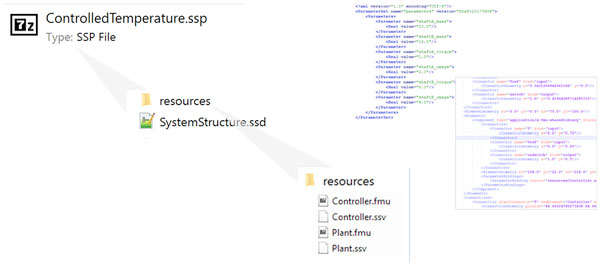FMIの新しいコンパニオン・スタンダード:SSP

This blog post is relevant for those who are familiar with the Functional Mock-up Interface and are interested in learning about the emerging companion standard, System Structure Parameterization (SSP).
The Functional Mock-up Interface (FMI) has been a game-changer in simulation technology. In less than ten years it has gone from idea, to research project topic, to an integral part of toolchains and workflows that support thousands of engineers world-wide.
Today there are more than 100 tools that support FMI – enabling engineers to transfer simulation models from one tool to another. A tools’ acknowledgement and support is critical to FMI standard acceptance; however the real benefit is not the ability to transfer model between tools but rather the benefit of transferring and exchanging models between engineers, teams, and companies – people!
With that said, many companies are still only in the beginning of realizing the full potential of FMI. Utilizing the FMI standard allows people to package advanced simulation models into a jigsaw puzzle piece, hiding internal complexity and exposing a limited interface.

So, why a new standard?
In a typical organization you have many teams that generate varying models using varying tools. We already know that engineers, teams, and companies would benefit from having a model available in an easily accessible way – using the FMI standard. But, to get the most out of FMI (and simulation models in general), people need to be able to connect their puzzle pieces. The pieces must also have the right interface to fit together without a lot of manual work on carving out adaptors.
This is the basis and reasoning for the new FMI standard, SSP.

SSP stands for System Structure and Parameterization. The standard defines an open format for describing systems of interconnected FMUs and the parameterization of such systems. It can also specify multiple configurations of a given system.
SSP is developed as a companion standard to FMI, therefore it is not to be part of the FMI standard itself. Standardization is driven by researchers in the FMI community, and has attracted a large amount of interest from industry. Development of SSP has been on-going for a few years, and the first release is scheduled for early 2018. Many tool vendors have begun preparing and users are eagerly waiting.
With SSP you can describe how FMUs are connected to other FMUs and to external inputs and outputs. Optionally, graphical layout information can be provided to visualize system structure in a standardized way and allow for drag-and-drop type modeling.

The system model can be saved as a zip-file with extension .ssp (just like FMUs). The zip file includes an XML file that describes model structure. Included FMUs can be placed in a resource folder or referenced as links to external locations.

Unlike FMI, SSP is not an executable format, it only describes the system. It is up to tools to implement functionality for co-simulation of the system.
How has Modelon prepared for SSP?

Modelon has just launched FMI Composer, the first tool on the market built entirely on the FMI and SSP standards.
Key Features:
- Import FMUs and view their information
- Create and edit SSP models graphically
- Convert FMUs from ME to CS
- Specify FMU interfaces and generate interface models in Simulink and Modelica that can be used to build an FMU that complies with the interface.
- Export the SSP system model to an executable FMU that has an embedded co-simulation engine. This allows you to simulate SSPs in any tool that is capable of FMI import: more than 100 as of today!
